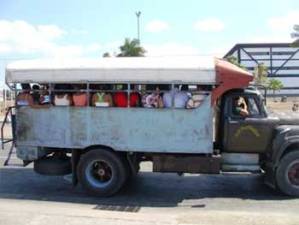Urban Transportation in Cuba
HAVANA TIMES, May 4 — Urban transportation, as the system vehicles for moving people within cities, is one of the most pressing problems in Cuba.
Our economic and logistic inability to purchase automobiles is the result of the economic embargo on the island, but it’s also due to the disastrous handling, decision making and allocation of resources by the government.
The result was people doing all types of things to get a car, since private exchanges were illegal. Only recently was the selling of cars decriminalized.
 The inventiveness of Cubans is unlimited when it comes to survival and tackling one of our biggest daily headaches: transportation. To deal with this, people have implemented several ways to achieve the movement of so many souls outside of the fabulous world of the individually owned automobile.
The inventiveness of Cubans is unlimited when it comes to survival and tackling one of our biggest daily headaches: transportation. To deal with this, people have implemented several ways to achieve the movement of so many souls outside of the fabulous world of the individually owned automobile.
State-administered public transportation has not succeeded, is not succeeding and will never succeed at supplying the ever-increasing needs of the population (paraphrasing the terminology of our old “scientific communism” courses, now renamed “socio-political theory”).
So, leaving us no choice, we’ve had to turn to private transportation, thanks to which we can usually get to where we’re going on time or not arrive as late as we would otherwise.
 What’s curious is that this means of transportation in Cuba has a range of providers.
What’s curious is that this means of transportation in Cuba has a range of providers.
One form is of course the fixed-route, multi-passenger jitney taxis, which are mostly old Fords, Chevrolet, Willys, etc. In Havana these have been baptized “almendrones” (or “big almonds”) owing to the shapes of those enormous jalopies from the 1950s).
People also ride on motorcycle/taxis, individually-owned TZ, MZ, Jaguas or other brands of motorcycles dating back to the 80’s, which was when they were imported here from the countries of the now-extinct East European socialist bloc.
 Another form of transport is in trucks and vans that cover the same routes as the public buses. These are most commonly used in places like Santiago de Cuba.
Another form of transport is in trucks and vans that cover the same routes as the public buses. These are most commonly used in places like Santiago de Cuba.
With no shortage of mechanics, some of these creative individuals came up with “Bici-taxis” (bicycle-rickshaws), which take fourth place on the list of the most used forms of transportation here. What’s most notable is that these aren’t phenomena unique to this or that city; bicycling is used in every city and town in Cuba to get people here and there.
And since we’re such a traditionalist people, there’s always the horse-drawn wagon, that ancient means of past centuries. As singer Silvio Rodriguez once said: “The past is winning new fame.”
 What’s more, this form of locomotion in not used exclusively in the historic city of Bayamo, where most citizens get around in wagons and carriages. Nor is it limited to the streets of Old Havana, where it can be seen as a kind of gimmick to entertain tourists with memories of colonial Cuba.
What’s more, this form of locomotion in not used exclusively in the historic city of Bayamo, where most citizens get around in wagons and carriages. Nor is it limited to the streets of Old Havana, where it can be seen as a kind of gimmick to entertain tourists with memories of colonial Cuba.
In all provincial capitals, municipalities and villages, horse-pulled wagons play a significant role in getting people to work and schools, to appointments, or just being able to travel from more distant locations.
Our different types of urban transportation will one day be museum pieces that illustrate how we lived in Cuba for more than half a century.







The best example of the embargo being lifted partially each time castro regime needs something is transport branch. Cuba needed buses, the embargo did not works and regime could buy Leyland buses to England……. again needed buses and the inexistent embargo did not work again and regime could buy Hino buses to Japan….. and so on several times including Chevrolet cars to create a taxi fleet …… regime could to buy locomotives, ships, more cars from Italy, France and other “capitalist” countries while regime got for free Zils, Ladas, Was, Roburs, and motors to fabricate Giron buses from USSR and Skodas, Polskys, and Fiats from other “brother” countries in East Europe…… I believe Cuba is the country that more help got to solve transport problem…… but help does not means nothing if you have your country productive forces tied….. with such internal blockade in function you will never get solved any problem but will create more and more problems over the accumulated ones……….
It’s not true that state-administered public transport cannot work: it does even in the advanced capitalist countries. I suppose the problem in Cuba is the lack of investment: that’s nothing to do with state-ownership, it’s all about Cuba’s relatively low level of development.
If there are enough buses running on time, with a good frequency, wide choice of routes and affordability: then
there is no public transport problem.